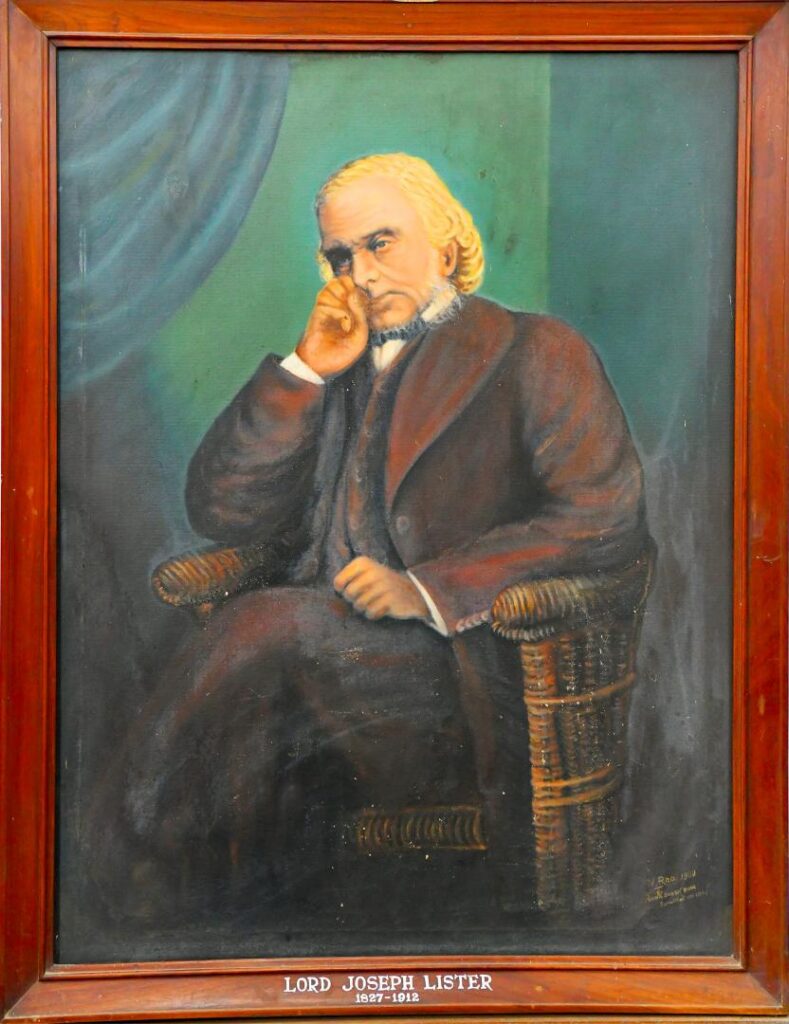Guntur Medical College 1978 Batch
Portraits - Guntur Medical College
Albert Einstein

Above the door of entrance on the wall hangs the portrait of Albert Einstein painted by Bhalabhadrapathruni. He is depicted as having white hair and a thick white moustache. Wearing a green pullover, he is seated on a wooden chair with a long backrest in front of a table on which are laid three books for study. A globe is seen on the table. In the background are two shelves stacked with books. Behind him on the wall is hung a portrait of two persons.
Born on 14th March, 1879 at Ulm in West Germany, Albert Einstein obtained his Doctorate from Polytechnic Academy of Zurich in the year 1905 and gained employment in the Swiss Patent Office, quite an obscure position. In the same year, seemingly out of the blue, he published four research papers, each containing a milestone discovery in physics: the special theory of relativity, the equivalence of mass and energy, the theory of Brownian motion and the photon theory of light. Till then, nobody had even a hint of Einstein’s later brilliance; indeed, some of his teachers thought him to be rather dull! He gained worldwide acclaim in 1919 when his enunciation of the theory of relativity was experimentally verified. Two years later he was awarded the Nobel prize in Physics for his discovery of the photoelectric law. The invitation by the Americans to pursue his research made him cross the Atlantic, and he started working towards unifying the laws of physics at the Institute of Advanced Studies at Princeton from the year 1933. It is a fact, regrettable as it might be, that a great scientist like Einstein was unsuccessful and unproductive after his initial brilliance. Only recently have unification theories appeared in Physics.
Einsteinium, symbol Es, named after Einstein, is a synthetic element of the actinide series, the seventh transuranium element with atomic number 99. It does not occur in nature but can be produced by intense neutron irradiation of Uranium-238. It was identified by Albert Ghiorso at Berkeley, California in debris taken from the first thermonuclear or hydrogen bomb explosion in the South Pacific in November 1952.
Joseph Lister

Inside the library on the side wall before the issue desk is the beautiful oil on canvas portrait of Joseph Lister, the pioneer of antisepis in surgery. This great person is a handsome figure with lovely features, long white hair and a beard but no moustache. He wears a bow. Seated cross-legged on a cane chair with arm rests, he is seen placing his left hand over the left thigh and the right hand supporting his chin. The long “surgeon”s fingers” of the right hand are folded and the tip of the index finger is touching the forehead. The artist catches him in a pensive mood. The three-piece brown suit and the Victorian bow make him truly majestic and lordly. He was, in actual fact, an English Lord.
First Baron Lister of Lyme Regis, he was born on 5th April, 1827. Having worked as an Assistant to James Syme of Edinburgh he later became his son-in-law. Lister was elected Regius Professor of Surgery at Glasgow University in the year 1859 and Surgeon to the Glasgow Royal Infirmary in the year 1861. He began using carbolic acid as an antiseptic agent in the year 1865 having been inspired by the work of Louis Pasteur. In the year, 1877, he concluded that his method of antisepsis reduced the danger to life from surgery, a “milestone in making surgery safe for the patient”. At the time of his retirement in the year 1896, his principle was universally accepted and today he is acclaimed as the Father of antiseptic surgery. Imagine: this basic fact about safe surgery was unknown a little over a hundred years ago!
Hugling Jackson

On the other side wall hangs the portrait of Hugling Jackson. The artist depicts Jackson as an aged man seated on a wooden chair with arm rests. He wears a white shirt and a brownish three-piece suit. The coat is long and the tie, broad. His partially closed eyes perhaps reflect the strain of long years of observation that contributed so much to medical progress. He is seen with long white hair combed backwards on a partly bald head. His long white moustache merges with the beard.
Born on 4th April 1835 in Hammerton, Yorkshire, England, Jackson pioneered the study of epilepsy, speech defects and disorders of the nervous system resulting from injury to the brain and spinal cord. To this day his work continues to be well documented and useful. In 1864 he corroborated the discovery of Paul Broca, a French surgeon, (that the speech centre of right handed persons is located in the left cerebral hemisphere and vice versa) by associating aphasia in right handed persons with disease of the left cerebral hemisphere. His contribution to the understanding of epilepsy makes the medical profession still call it Jacksonian epilepsy. He was a Physician to the National Hospital for the Paralysed and Epileptic as well as to London Hospital.
Charaka

This painting shows Charaka, one of the greatest Ayurvedic physicians of all time, treating a patient. The canvas reveals the patient, a Maharani clad in a green saree and adorned with valuable jewels around her neck, while the physician wears a necklace, ear rings and a bracelet (kankanam) on the left wrist. The King is seen watching Charaka examining the pulse of the patient and anxiously awaiting the verdict. Nevertheless, the King is depicted smiling and not worried since it seems he has full faith in the abilities of his doctor. The Princess is seen grasping her mother’s arm. The physician’s assistant is seen in the background. A fruit bowl and a flower vase are kept on the side table. Dwarapalakas (security guards) with spears in their hands can also be seen.
Bhalabhadrapathuni was invited by me to refurbish some of the old paintings which were spoiled. He voluntarily did the job and also offered to sketch the portrait of Charaka. He used to come even in hot weather and worked in his old Modeller’s room in the third floor to complete the painting of Charaka before I retired from service.











